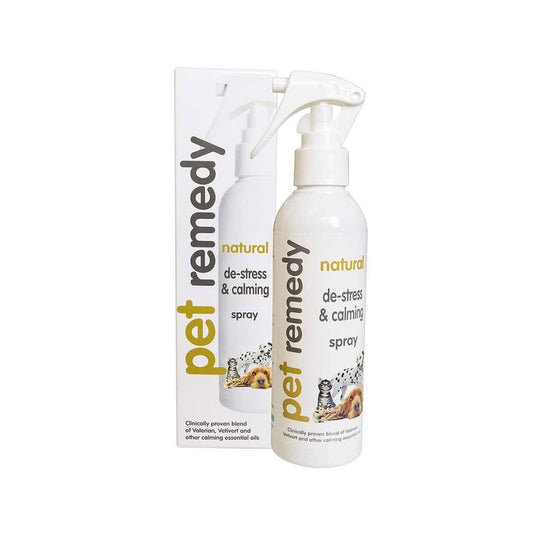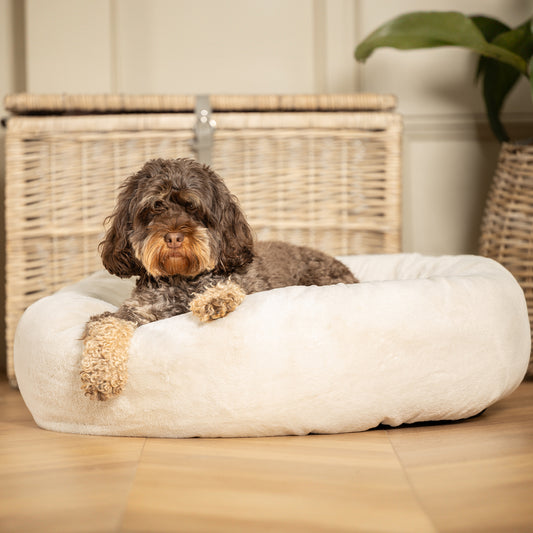We are well into the Autumn season; summer has passed, and the red leaves are falling. This only means one thing; Guy Fawkes night is just around the corner and not long after is Guy Fawkes Night. Whilst we’re enjoying a pumpkin spice latté and deciding where to go and watch the fireworks, we mustn’t forget the furry members of the family. However, the lead up to Bonfire Night can be difficult season for many dogs.
All the uproarious blasts and blazes made by fireworks and bonfires can be terrifying for them, making them stressed and anxious, possibly putting their wellbeing in danger. It is important to consider your canines best interests on Bonfire Night – especially if it's their first one.
Puppies are likely to be more scared than they have ever been, due to the unfamiliar and potentially frightening sounds and sights. But there are ways to introduce them to fireworks before November 5th and prepare them. We thought we’d give you our tops tips for keeping your pets safe and calm at this noisy time of year, as well as recommending our top calming products.
Why are dogs scared on bonfire night?
Bonfire Night can be a troubling time for many dogs. With the constant loud bangs and bright flashes, it is understandable why some dogs can be so frightened by the evening. Here are some of the main reasons why dogs are likely to be scared because of fireworks:
- Loud explosive noises – Dogs have an extremely acute sense of hearing, much more so than humans. The loud bangs and crackles that fireworks bring are even louder to your pup and likely to be extremely alarming!
- Bright flashes – Fireworks also make bright flashes at a usually dark time of day. This is unfamiliar to dogs and they may become scared at this.
- Can make your dog feel trapped – Fireworks are a difficult thing to escape, especially on Bonfire Night. Your dog may be likely to try to run away or hide, however they will struggle to escape them and may feel frightened or anxious.
- A feeling of the unknown and unpredictability – Bonfire Night to your dog, is just another, normal evening. The unpredictability of bangs and flashes is likely to cause restlessness and potentially act out of character.
Can you get a puppy used to fireworks?
The best time to get your dog used to fireworks is when they are a puppy – as a dog who has already experienced a bonfire night in their life may already be frightened by the loud sounds and bright flashes. Preparing your pup begins now – you can start by turning up the noise on the television to gradually ease them into louder noises and bangs, especially during action scenes with frequent loud bangs. Once your pup is more used to that try recordings of firework displays to prepare them for the real thing. However, if your pet suffers from noise phobia or is quite anxious, the proposed preparation may worsen their situation.
What to do with dogs on bonfire night
When dogs feel scared or anxious, they will look to find a space where they can try to relax and feel comfortable. The place they choose will likely be a dark place with one entrance to hide away from the loud bangs from fireworks. At Lords & Labradors, we understand that sometimes your dog will feel scared, especially on Bonfire Night! This is one of many reasons why we recommend a Lords & Labradors Crate Set for your pup! It provides the perfect escape and hiding place for them to find comfort and shelter when they are feeling anxious or scared.
How to keep a puppy calm during fireworks?
The loud noises and bright flashes that fireworks bring can be an anxious time for anyone – so put yourself in your puppies’ position, scared will likely be an understatement. There are ways in which you can distract and calm your dog through their fears:
- Distraction from the loud noises via radio or TV – this can soften the loud bangs of the fireworks which should soften the fright for your pup.
- Anti-anxiety kits and products for dogs – here at L&L we understand that your dog may, from time to time, struggle with high levels of anxiety or fright. We offer a range of products perfect for situations such as Bonfire Night, where your dog or puppy is likely to be scared.
- Do not tell your dog off – it is important not to scare or upset your dog further than they already are. Try to act as normal as possible, sending your pup positive signals in the process by acting calm and happy.
- Do not take your dog to a firework display – Even if you think your dog will not be phased by fireworks or a bonfire, is it really worth taking the risk. A loud noise or bright flash could be enough to spook them into running away from you in a panic.
- Ensure they don’t have access to leave the front door – sounds a straightforward thing to say to some dog owners, but the strange noises and flashes of light that bonfire night brings could be enough to scare your dog into bolting to escape via the front door. If you need to open your front door, we advise shutting your dog in another room whilst doing so to ensure the highest level of safety.
How to help a puppy when fireworks are going off
Preparing your Dog for Guy Fawkes Night is difficult. The unfamiliarity of the evening could cause high levels of stress and anxiety for your four-legged friend. However, there are some ways in which you can best prepare to try and make the evening as stress free for your canine:
- Walk in advance – Walking your dog in advance will ensure they have ample opportunity to relieve themselves before becoming scared by fireworks. Tiring them out may also help them relax more later in the evening.
- Feed in advance – Feeding your dog before any expected fireworks would be advised, as an anxious or scared dog may not want to eat.
- Ensure their water bowl is filled – Anxious dogs are likely to pant, drool and generally be thirstier. Regular checking their water bowl will ensure they have a drink available. It may be worth encouraging them to drink throughout the evening as they may forget due to fear.
- Shut curtains and blinds – This will ensure any bright flashes are minimalised which could lead to scaring your pup.
- Double check the security of your garden – Letting your dog out to relieve themselves whilst fireworks are going off may be necessary, especially for puppies. Making your garden secure will ensure your dog can not escape in an attempt to run away from the loud explosions and bright flashes.
- Anti-anxiety and calming products – At Lords & Labradors we understand that your dog may need something extra to support them through scary and anxious moments. Our range of anti-anxiety and calming products ensure that your dog will be calmer through traumatic evenings such as Bonfire Night.
Time to check your dog's microchipping details?
The Autumn can bring a variety of occasions that can spook your canine friend, especially Halloween and Bonfire Night. It makes early October the perfect time to check you dogs microchip details, and ensure they are wearing their collar with ID tag as often as possible. Loud noises and unfamiliar sights that occasions like Bonfire Night bring (with fireworks) are likely to be things that could spook your pup into attempting to run away. We know that the last thing any pet owner wants to do is lose their pet – but ensuring that their details are up to date will best prepare you for that worst case scenario and help you find them just in case they do go missing!
Top Dog Calming Products To Use On Bonfire Night
- Woof & Brew Anxious Hound Herbal Tonic - This healthy tonic for dogs is a great daily supplement for anxious or nervous dogs and is ideal to give them before stressful situations such as fireworks. It's a special blend, rich in vitamins and minerals, best served over food or in their water. Each bottle has approximately 60 servings (please read the label for serving details).
- Beaphar Cani Comfort Collars - The Beaphar CaniComfort Collars are great at relaxing your dog, they use pheromone technology to help calm your dog. Pheremones are one of the ways dogs communicate, the Dog Appeasing Pheromone (DAP) is naturally produced by mums when they are feeding their puppies. These collars contain a replica of the DAP which is familiar to all dogs so are instantly calming for all dogs. The collars are effective for up to four weeks so are perfect for over the Halloween and Bonfire festivities. The collar can have effects in as little as 15 minutes but we recommend putting it on a day or two before Halloween in case anyone has any early fireworks go off, simply fit the collar around your dog’s neck, fasten and cut off the excess. Perfect for calming and providing reassurance to your dog in what can be a scary time of year for our four-legged-friends.
- Calming Anti-Anxiety Donut Beds - Here at Lords & Labradors we design our products specifically with your dog’s needs in mind, our faux-fur donut beds are perfect for reducing your dog’s anxiety. The plump soft walls of the donut beds have been designed to cocoon your dog to sleep and help calm them. They come in the softest faux-fur fabric so are perfect for snuggling in.
- Pet Remedy All-in-one Calming Kit - There are a number of different options in the Pet remedy range including plug-in diffusers and room sprays. Pet Remedy contains a host of natural oils that de-stress and calm nervous pets. Our favourite product is the All-in-One Calming Kit that includes a room spray, plug-in diffuser and calming wipes. All the things you could need to help keep your pet calm through the celebrations.
We hope you enjoy the festivities of the season. If you have a pet and you're concerned about their anxiety levels, don't panic! Try one of the solutions above and do your best to keep them feeling secure.
If you have any questions about this article, or any other topic, do get in touch. You can chat to us via the Chat link on the bottom right hand side of our website, email sales@lordsandlabradors.co.uk or call us on 01790 720900.






















































.jpg?v=1698672952691&options=)










































